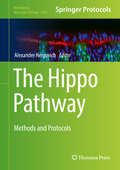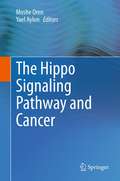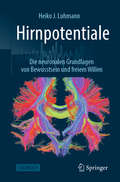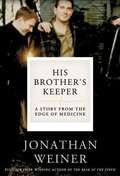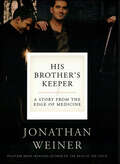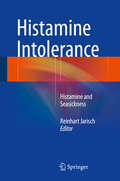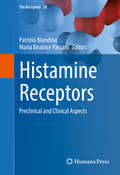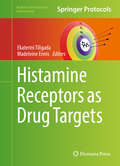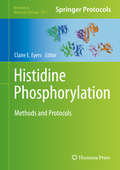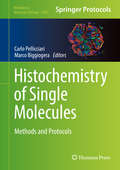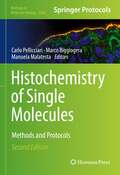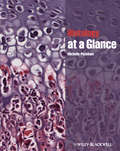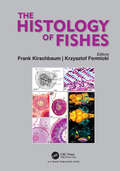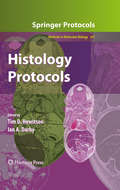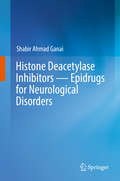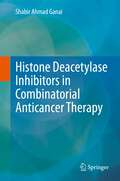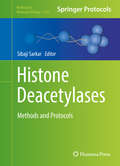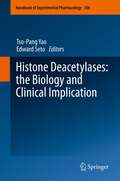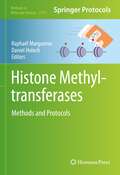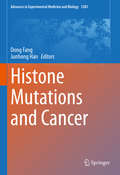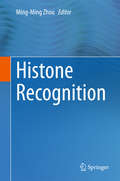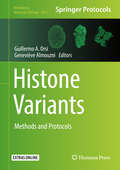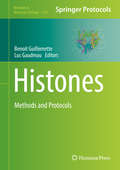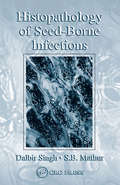- Table View
- List View
The Hippo Pathway: Methods And Protocols (Methods in Molecular Biology #1893)
by Alexander HergovichThis detailed book covers numerous expert methodologies to examine Hippo signaling on the structural, molecular, cellular, and organismal level. Beginning with a section on Drosophila genetics, the volume continues with parts exploring molecular and cell biological studies of the Hippo pathway, the use of structural biology and biochemistry, and a brief look at the Hippo pathway in mouse models. Written for the highly successful Methods in Molecular Biology series, chapters contain introductions to their respective topics, lists of the necessary materials and reagents, step-by-step, readily reproducible laboratory protocols, and tips on troubleshooting and avoiding known pitfalls. Comprehensive and practical, The Hippo Pathway: Methods and Protocols equips newcomers and specialists alike with key methodologies to accurately define the status of Hippo signaling in their experimental settings.
The Hippo Signaling Pathway and Cancer
by Moshe Oren Yael AylonThe Hippo signaling pathway is rapidly gaining recognition as an important player in organ size control and tumorigenesis, and many leading scientists are showing increased interest in this growing field and it's relation to cancer. For instance, for the past two years, over 60 researchers from all over the world, have gathered annually for an intensive "Hippo Pathway Workshop" in Rome, Italy. This year, the workshop has been sponsored by Keystone Symposium and will be held in Monterey, California in Spring, 2013.This confirms the growing interest for the Hippo field within the international scientific community. The prospective list of the chapters covers virtually all aspects of tumor biology. This is because members of the Hippo Pathway have been associated with numerous well-established cell signaling pathways, just to name a few; Ras, Wnt, TGFbeta and p53. Moreover, Hippo signaling is not solely involved in regulating "classic" tumor characteristics such as cell proliferation, survival and growth, but is also diversely involved in cell-autonomous and non-cell-autonomous differentiation, migration and organ size control. The primary audience are researchers interested in basic science in the areas of tumor suppression, cell cycle and size regulation, development and differentiation.
Hirnpotentiale: Die neuronalen Grundlagen von Bewusstsein und freiem Willen
by Heiko J. LuhmannDer Neurophysiologe Heiko Luhmann erforscht seit mehr als 35 Jahren die Funktionsweise von Nervenzellen und neuronalen Netzen. In diesem spannenden und provozierenden Buch informiert er Sie über die neuesten Erkenntnisse der Hirnforschung und wie diese unsere Vorstellungen über das Bewusstsein und den freien Willen verändern. Sie erfahren, dass die Trennung von Körper und Geist aus neurowissenschaftlicher Sicht nicht aufrechterhalten werden kann und wie unterschiedliche Wissenschaftsdisziplinen ein neues Konzept zur Funktionsweise unseres Gehirns entwickeln. Das Buch beschäftigt sich mit spannenden grundlegenden Fragen, wie:Warum gibt es überhaupt Gehirne? Wie kommt die Welt in den Kopf? Wie sind interne neuronale Karten aufgebaut? Wo ist das Bewusstsein lokalisiert und wie entsteht es? Hat der Oktopus ein Bewusstsein? Ist das Gehirn eine Prädiktionsmaschine? Erlaubt das Konzept der prädiktiven Kodierung einen freien Willen? Entwickeln wir mit Hilfe eines Hirn-Computer-Interfaces ein höheres Bewusstein? Sind wir technologisch in der Lage Gedanken zu lesen und zu erzeugen? Verfügen Roboter eines Tages über ein künstliches Bewusstsein?
Hiroshima to Fukushima
by Eiichiro OchiaiSet against a backdrop of the recent disaster at the Fukushima nuclear power plant, "Hiroshima to Fukushima" examines the issue of radiation safety. The author provides important and accurate scientific information about the radioactive substances arising from nuclear power plants and weapons, including the effects of this radiation on living organisms. Currently, humankind is at a crossroads and must decide whether to phase out or increase its reliance on nuclear power as weapons and an energy source. Although a few countries, mostly European, have vowed to abolish nuclear power as an energy source, many other countries are about to increase their nuclear power programs. This book is written from a Japanese perspective and thus provides an alternative to views of Western writers. The author includes rigorous scientific analyses, however maintains a broad scope, which allows the book to be accessible to decision-makers and non-specialists.
His Brother's Keeper: A Story from the Edge of Medicine
by Jonathan WeinerFrom the Pulitzer Prize-winning author of "The Beak of the Finch" comes a book about the new biology and how it touches a defiant family-in-crisis fighting an incurable disease.
His Brother's Keeper: A Story from the Edge of Medicine
by Jonathan WeinerStephen Heywood was twenty-nine years old when he learned that he was dying of ALS -- Lou Gehrig's disease. Almost overnight his older brother, Jamie, turned himself into a genetic engineer in a quixotic race to cure the incurable. His Brother's Keeper is a powerful account of their story, as they travel together to the edge of medicine.The book brings home for all of us the hopes and fears of the new biology. In this dramatic and suspenseful narrative, Jonathan Weiner gives us a remarkable portrait of science and medicine today. We learn about gene therapy, stem cells, brain vaccines, and other novel treatments for such nerve-death diseases as ALS, Alzheimer's, and Parkinson's -- diseases that afflict millions, and touch the lives of many more."The Heywoods' story taught me many things about the nature of healing in the new millennium," Weiner writes. "They also taught me about what has not changed since the time of the ancients and may never change as long as there are human beings -- about what Lucretius calls 'the ever-living wound of love.'"This P.S. edition features an extra 16 pages of insights into the book, including author interviews, recommended reading, and more.
Histamine Intolerance
by Reinhart JarischHistamine is an important mediator of allergic diseases, but knowledge of histamine as a cause of numerous non-allergic symptoms and signs is limited. This book offers wide-ranging coverage of histamine intolerance. There is extensive background discussion of the origin of histamine, its content in food and alcoholic beverages and intolerance to red wine. Diagnosis of histamine intolerance is explained and the various symptoms of histamine intolerance are clearly described. Subsequent chapters cover the relation of histamine to a wide variety of conditions, including drug intolerance, atopic dermatitis, seasickness and osteoporosis. This book will prove of value in clinical practice by facilitating differential diagnosis, which is by no means straightforward given the multiplicity of symptoms of histamine intolerance and by assisting in the selection of therapeutic measures.
Histamine Receptors
by Patrizio Blandina Maria Beatrice PassaniA comprehensive and detailed overview of the current state of preclinical research on histamine and histamine receptors. Part of the book focuses on novel approaches to the study of histamine receptors such as polymorphism, genetic linkage, and computational analysis, and on the use of new histaminergic ligands in diseases such as asthma and dermatitis. Several chapters will be devoted to the role of histamine in the control of homeostatic and behavioral responses such as the sleep-wake cycle, regulation of the blood brain barrier, food intake, alertness, itch, and memory formation and consolidation.
Histamine Receptors as Drug Targets
by Ekaterini Tiligada Madeleine EnnisThis book illustrates the current state-of-the-art in histamine research, with a focus on the appropriate methodologies to investigate the pharmacological properties and the therapeutic exploitation of HRs and their ligands. In addition, the range of techniques described provides an introduction to complementary cross-methodological disciplines beyond these fields. This multi-disciplinary approach is required to define the 'decision gates' that determine the development of more effective and safer therapeutic options for many forms of highly prevalent and debilitating diseases, such as asthma, dementias, dermatitis, and arthritis. Written for the Methods in Pharmacology and Toxicology series, chapters concentrate on practical, hands-on protocols from experts in the techniques. Authoritative and thorough, Histamine Receptors as Drug Targets seeks to aid pharmacologists, biochemists, drug discovery researchers, molecular biologists, chemists, toxicologists, lab scientists, medical doctors, principle investigators, research scientists, lab directors and technicians, as well as graduate students around the world in pursuing the study of this vital scientific area.
Histidine Phosphorylation: Methods and Protocols (Methods in Molecular Biology #2077)
by Claire E. EyersThis volume details the current understanding of roles and regulation on histidine phosphorylation, describing methods for the characterization of protein phosphorylation on histidine. Chapters guide readers through in vitro systems, cell-based systems, comprehensive background review articles on histidine kinases and phosphatases. Written in the highly successful Methods in Molecular Biology series format, chapters include introductions to their respective topics, lists of the necessary materials and reagents, step-by-step, readily reproducible laboratory protocols, and tips on troubleshooting and avoiding known pitfalls. Authoritative and cutting-edge, Histidine Phosphorylation: Methods and Protocols aims to ensure successful results in the further study of this rapidly growing field.
Histochemistry of Single Molecules
by Marco Biggiogera Carlo PellicciariThis detailed volume explores numerous histochemical techniques through a series of lab-tested protocols for the detection of specific molecules or metabolic processes, both at light and electron microscopy. More in detail, the book is divided into six sections covering a variety of chemical targets. It begins with a section on vital histochemistry and continues with chapters on histochemistry as it relates to lectins, proteins, lipids, DNA and RNA, as well as plants. The volume also contains four overview chapters on vital histochemistry, lectin histochemistry, and DNA fluorochromes. Written for the highly successful Methods in Molecular Biology series, chapters include introductions to their respective topics, lists of the necessary materials and reagents, step-by-step, readily reproducible laboratory protocols, and tips on troubleshooting and avoiding known pitfalls. Authoritative and practical, Histochemistry of Single Molecules: Methods and Protocols aims to effectively help scientists in very different research fields to elucidate biological issues though a unique approach to molecular biology in situ.
Histochemistry of Single Molecules: Methods and Protocols (Methods in Molecular Biology #2566)
by Carlo Pellicciari Marco Biggiogera Manuela MalatestaThis volume details histochemical techniques for the detection of specific molecules or metabolic processes, both at light and electron microscopy. Chapters are divided into seven sections covering Vital histochemistry, Carbohydrate histochemistry, Protein histochemistry, Lipid histochemistry, Nuclear histochemistry, Plant histochemistry and Histochemistry for Nanoscience. Written in the successful Methods in Molecular Biology series format, chapters include introductions to their respective topics, lists of the necessary materials and reagents, step-by-step, readily reproducible protocols, and notes on troubleshooting and avoiding known pitfalls. The volume also contains three discursive chapters on Histochemistry in advanced cytometry, Lectins and Detection of molecules in plant cell walls by fluorescence microscopy. Authoritative and cutting-edge, Histochemistry of Single Molecules: Methods and Protocols, Second Edition aims to be a useful practical guide for researchers to help further their study in this field.
Histology at a Glance (At A Glance Ser. #50)
by Michelle PeckhamThis brand new title provides a highly illustrated and unambiguous introduction to the science, structure and function of cells, their related pathology, and in particular, helps readers master the basic principles of recognizing features of histological sections. Histology at a Glance: Presents the perfect combination of text and image; key concepts are explained and superbly illustrated Provides coverage of all the main body systems and the components of the tissues of these systems Features practical information on microscopy, including sample preparation and magnification Includes hints and tips to help recognize features in a histological specimen, and overcome common difficulties Contains self-assessment questions to help test learning and recognition Links to the author's histological website, which features many more tips and samples, at www. wiley. com/go/histologyataglance Histology at a Glance is the perfect guide for medical, dentistry and biomedical science students, junior doctors, and is ideal for independent learning programmes in histology.
The Histology of Fishes
by Frank Kirschbaum Krzysztof FormickiThe book is a multi-authored book of 18 chapters comprising the state of the art work of all relevant topics on modern fish histology from 28 authors from ten countries. The topics include Introduction to Histological Techniques, Integument, Fish Skeletal Tissues, Muscular System, Structure and Function of Electric Organs, Digestive System, Glands of the Digestive Tract, Swim Bladder, Kidney, Ovaries and Eggs, Egg Envelopes, Testis Structure, Spermatogenesis, and Spermatozoa in Teleost Fishes, Cardiovascular System and Blood, Immune System of Fish, Gills: Respiration and Ionic-Osmoregulation, Sensory Organs, Morphology and Ecomorphology of the Fish Brain, and Endocrine System. Structural and functional aspects are treated and in a comparative way fish diversity at various taxonomic levels is integrated.
Histology Protocols
by Ian A. Darby Tim D. HewitsonWith much of what we know about the pathogenesis of disease coming from the systematic and careful study of histological material, histology has proven to be an incredibly valuable area of study. In "Histology Protocols", expert researchers in the field contribute detailed methods involving the preparation of tissue, providing an overview of fixation, embedding, and processing, along with the required techniques for the retrieval of RNA from histological sections, followed by sections on routine and specialist histological staining techniques, including immuno-, lectin, and hybridization histochemistry, histological staining, as well as specific methods for the in situ identification of hypoxia and apoptosis, and details on the advances in imaging and image analysis. Written in the highly successful Methods in Molecular BiologyTM series format, chapters include introductions to their respective topics, lists of the necessary materials and reagents, step-by-step, readily reproducible laboratory protocols, and notes on troubleshooting and avoiding known pitfalls. Authoritative and cutting-edge, "Histology Protocols" will provide molecular biologists with the basic histochemical techniques and histologists with the molecular techniques necessary to realize the potential of their resource.
Histone Deacetylase Inhibitors — Epidrugs for Neurological Disorders
by Shabir Ahmad GanaiThis book provides an outline of epigenetics as a whole, while also specifically examining a range of epigenetic players, including histone acetyl transferases (HATs) and histone deacetylases (HDACs). It chiefly focuses on the emerging targets of HDACs and their implications for various neurological disorders, while also discussing the drawbacks of current therapeutic strategies, the classification of HDAC inhibitors, and their promising effects in connection with specific neurological disorders. The book explores the potential use of these inhibitors as novel therapeutic agents, considers the current challenges involved in using them to tackle neurological complications, and offers a novel solution by designing isoform-selective inhibitors and employing combinatorial therapeutic strategies. Its final section, which explores future directions, elaborates on the possibility of enhancing HDAC inhibitors’ therapeutic efficacy against various neurological complications.
Histone Deacetylase Inhibitors in Combinatorial Anticancer Therapy
by Shabir Ahmad GanaiThis book reviews the latest developments in the design, synthesis, and molecular mechanism of action of Histone Deacetylase (HDAC) inhibitors in the context of potential cancer therapy. HDAC inhibitors are emerging as promising anticancer drug molecules that promote growth arrest, differentiation and apoptosis of cancer cells with tumor selective toxicity. The book begins with an overview of various epigenetic modifying enzymes that are involved in cancer transition and progression; before exploring the potential of HDACs in cancer treatment. It provides a classification of HDAC inhibitors based on their structural attributes, and addresses HDAC-induced cytotoxicity.. Lastly, it discusses and assesses the rationale behind therapies that combine HDAC inhibitors with other anticancer agents to treat solid tumors. Given its scope, it offers a valuable resource for all researchers, clinicians, and students working in formulation, drug discovery, oncology, and personalized medicine.
Histone Deacetylases
by Sibaji SarkarThis volume provides different methodologies for all classes of histone deacetylases, which includes detailed procedures on Class I and II histone deacetylase inhibitors, SIRT inhibitors, and bromodomain inhibitors. "Histone Deacetylases: Methods and Protocols" is divided into four sections: Sections A and B describe methodologies used to detect the activity, function, or chromatin location of HDACs 1 through 11, with Section A discussing Class I and Section B discussing class II histone deacetylases; Section C focuses on the methodologies for cloning and characterizing the acetylation of SIRTs 1 through 7; and Section D describes methods related to histone deacetylase inhibitors. Written in the highly successful "Methods in Molecular Biology "series format, chapters include introductions to their respective topics, lists of the necessary materials and reagents, step-by-step, readily reproducible laboratory protocols and tips on troubleshooting and avoiding known pitfalls. Thorough and cutting-edge, "Histone Deacetylases: Methods and Protocols, "is a valuable resource for investigators working on epigenetics, molecular biology, and genetics.
Histone Deacetylases: the Biology and Clinical Implication
by Edward Seto Tso-Pang YaoThe book highlights work from many different labs that taught us abnormal HDACs potentially contribute to the development or progression of many human diseases including immune dysfunctions, heart disease, cancer, memory impairment, aging, and metabolic disorders.
Histone Methyltransferases: Methods and Protocols (Methods in Molecular Biology #2529)
by Raphaël Margueron Daniel HolochThis volume provides methods used to investigate histone methyltransferase function. Chapters guide readers through a comprehensive set of approaches that detail phylogenetic diversity, histone demethylase activities in vitro, generating chromatin substrates, auto-methylation, quantification of metabolites, protein purification, crystallization, X-ray structure, cryogenic electron microscopy, assessing genome-wide patterns, CUT&Tag in mouse embryonic tissues, chemical biology approaches, peptide SPOT arrays, nascent chromatin capture, ectopic protein tethering, computational models, and development of methyltransferase inhibitors. Written in the format of the highly successful Methods in Molecular Biology series, each chapter includes an introduction to the topic, lists necessary materials and reagents, includes tips on troubleshooting and known pitfalls, and step-by-step, readily reproducible protocols. Authoritative and cutting-edge, Histone Methyltransferases: Methods and Protocols aims to be a useful and practical guide to new researchers and experts looking to expand their knowledge.
Histone Mutations and Cancer (Advances in Experimental Medicine and Biology #1283)
by Dong Fang Junhong HanThis book focuses on histone mutations, especially those mutations closely related to cancer. Genetic mutations and epigenetic alterations contribute to the development of a variety of cancers: recent genetic studies have identified e.g. H3K27M and H3G34R/V mutation in over 75% of DIPG cases, H3.3K36M mutation in more than 90% of chondroblastoma cases, and H3G34W/L mutation in over 90% of giant cell tumors of bone. Given the high incidence and tumorigenesis effects of histone H3 mutations, they are also referred to as oncohistones.This book highlights the advances made in the area over the past 10 years, and offers a state-of-the-art summary of epigenetic alternation, gene expression, protein structure, drug discovery, immunotherapy, and mouse modeling of histone H3 mutations in various tumors. Chiefly intended to provide researchers and graduate students with an overall picture of these mutations, it will also be of interest to researchers in basic oncology, clinical oncology, and epigenetics, as well as academics and clinical oncology practitioners.
Histone Recognition
by Ming-Ming ZhouThis book provides a timely review of the role of histone modifications in epigenetic control of gene expression. Topics covered include: basic mechanisms of molecular recognition of histone post-translational modification (PTMs); combinatorial readout of histone PTMs by tandem epigenome reader domains; genome-wide profiling of histone PTM interactions; small molecule modulation of histone PTM interactions and their potential as a new approach to therapeutic intervention in human diseases. All chapters were written by leading scientists who made the original key discoveries of the structure and mechanism of evolutionarily conserved reader domains, which serve to direct gene transcription in chromatin through interactions with DNA-packing histones in a PTM-sensitive manner.
Histone Variants: Methods and Protocols (Methods in Molecular Biology #1832)
by Guillermo A. Orsi Geneviève AlmouzniThis volume compiles methodologies used for detailed studies of histone variants, from their basic properties to their functional roles in chromatin and as vectors of epigenetic information. Its four sections cover experimental approaches to probe the biochemistry of histone variants and variant nucleosomes; their dynamics throughout the cell cycle and at specific genomic locations; their functional impact on chromosome organization and genome stability; and their importance in development, disease and evolution. Written in the highly successful Methods in Molecular Biology series format, chapters include lists of the necessary materials and reagents, step-by-step, readily reproducible laboratory protocols, illustrations on the expected results, and tips on troubleshooting and avoiding known pitfalls. This anthology brings together contributions from many of the most highly recognized investigators in this community.Cutting-edge and thorough, Histone Variants: Methods and Protocols is a valuable resource for anyone interested in exploring the experimental and collaborative possibilities in this evolving field.
Histones
by Benoit Guillemette Luc R. GaudreauThis volume provides a comprehensive list of protocols for molecular biologists, biochemists and geneticists. Chapters cover protocols that further the study into protein complexes that modify chromatin either by adding or removing post-translational modifications, or by exchanging histone variants within the nucleosome. Written in the highly successful Methods in Molecular Biology series format, chapters include introductions to their respective topics, lists of the necessary materials and reagents, step-by-step, readily reproducible laboratory protocols, and tips on troubleshooting and avoiding known pitfalls. Authoritative and cutting-edge, Histones: Methods and Protocols aims to ensure successful results in the further study of this vital field.
Histopathology of Seed-Borne Infections
by Dalbir Singh S. B. MathurHistopathology of Seed-Borne Infections is the first book to provide comprehensive coverage of seed infection and disease. It includes an up-to-date account on the development and structure of seed, pointing out the structural variations in seeds of the plant families to which most crop plants belong. The text presents techniques and advice for his
